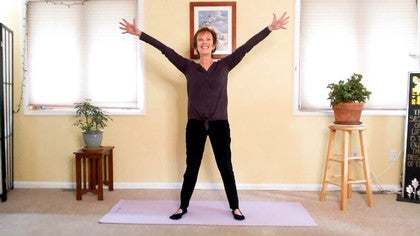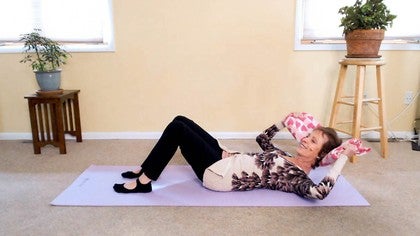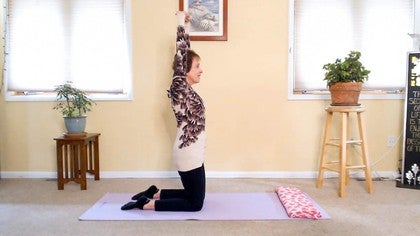Description
About This Video
Transcript
Read Full Transcript
Okay so, just find your spot. Relax, feel your feet. Feel your feet on the ground. Take a moment to just arrive. (exhales) let your mouth go.
Let your breath go. Take in the space. See the surroundings. Take in your environment. Just arrive, take a couple of moments to just be here, with yourself and me.
And then just find a good, comfortable stance. Legs not too wide, not too narrow. Whatever feels like you can just come into the space. Begin to come into your body and ground yourself down. Allow the knees to be soft.
Let go of any tension if you can, in the hips, the pelvis. Shake your arms out a little. Just relax and begin to bring your attention, from the surroundings. A little more directly into your body. Take some nice, easy breaths.
(exhales) Yeah, just shake it out and let things go. So we're gonna begin to sort of set up in a way, a standing dynamic posture, and go through the parts of your body. Just some simple directions, some simple guidance that's gonna help you when we move ourselves into the seated meditation. This you could call a, a standing meditation. So imagine that you have six limbs, you have two legs, two arms, a head and a tail.
And those are the vertical tracks in your body. And you can release down. You can release down through the legs, into the feet, into the ground. You can release down through the shoulders, into the arms and hands. You can allow the tail to release down, softening the knees, releasing the hips, shift your weight forward and back a little bit, just to feel the fullness of your foot, your feet on the ground.
Maybe shift a little bit side to side, just getting a sense of the fullness of your body. Three-dimensionally, look around, shift and then come back. And then as you stay, eyes open, eyes closed doesn't matter. Allow the two legs and the tail to act as a kind of a three-legged stool, so that you release the way to the pelvis, onto your legs. And you allow that ground to come into, to focus come into your awareness as a support.
And as you stay, imagine that somebody was behind you, somebody that you like and there was another pair of arms waiting for you. And that you could sit and release back into those waiting arms, so that your back is supported. It's not that you fall back or collapse into your friend, but that you can rely on that space behind you. And as you sense into those waiting arms that you can release into, you can really let your front soften. Can let your chest, let go a little.
Let your belly soften, you don't need to be hard down there. Again any subtle movements, swaying that helps you free it up, free it up, so you're not hardening into any of these positions. So you have the two legs reaching down, a subtle shift back letting the sacrum and the tail be like an anchor slightly behind your heels. And resting, resting into those waiting arms, relaxing the shoulders again, the neck, the jaw, the lips, the face and maybe take a hand and put it on the top of your head, not pushing but just to feel what's above. And as you stay and relax and breathe, have a sense that there is a sense of ascending possible, a lightness, a bouncing of the earthiness, the grounded-ness, a lightness, a subtle reaching.
You could gently move your head side to side, nod up and down, and then come back to this sense of centeredness. Once again, the verticals hanging, releasing the support, coming up through the ground and maybe really take a moment and notice how much you can spread your feet out on the ground and if you can do that and let the weight go down, down through the bones you start to feel the ground literally coming up, coming up from below floor level, deep, deep in the earth. Coming up, from the ground to support you from below. And then begin to shift side to side, to bring in the lateral or the horizontals. So you have the hanging verticals and you have the floating horizontals.
So literally where you focus across your eyes, shoulder girdle, the collarbone, shoulders, the arms hang off that. The ribs, there's a lot of nice play through the bottom ribs feeling into your deep core, horizontal shift. The organs and then the pelvis and the hips. Two legs have to come together through the center of the hips and connect through our core, through our center, through the sacrum. So you have your three legged stool.
You're waiting, receptive arms behind you that you can rest back into. So again and again, releasing the jaw, letting the mouth be soft so that the breath can flow, through the body and bring in another, another circle, circular movement, a flow that can come up the back, release down over the front of the head and skull and down. And let's actually just take a moment here and more consciously, bring the breath in. So we'll take what they call three cleansing breaths. In different traditions, it's just a way to center, dispel old air, dispel any bad energy and refresh.
So as you breathe in, you create a little tightening, a little density. So you bring the air in, you inhale and you can wrap all your fingers around your thumb and make a bit of a fist. And then as you exhale, release, send, push it out. Extending through the fingertips, feel the ground under your feet, see the room. One more time inhale, draw the breath in.
Little bit of squeeze, bring a little muscularity into it, and exhale. And let it go. And then let's take the attention now back down to the feet and the ankles. And I'm gonna get a little bit more specific, just play with it. You can't do it wrong.
Just take this time to take this little trip through your body and find yourself. So all the pads of the toes, you don't wanna grip them. You wanna try and let the toe pads release and be soft. I think of it like whiskers on a cat. So just, those are your feelers and space, right.
And then from there, come back onto the balls of your feet. The ball joints, like little push pins or little thumbprint cookies, the jam in the middle of the cookie. So big toe, second toe, third toe, fourth toe, pinky toe. Just see, shift from big toe to little toe. Can you sense the weightedness?
If I lifted you up in a moment, there'd be a print of you in the ground. And then coming back a little further, a sense of suspension. So we keep going back and forth between what is grounding? What is descending? And then what's the complimentary ascending or suspension that can come out of that in the body?
So a little bit of a sense of a lift or a doming or a little mini parachutes under the arches of your feet. And then come back a little further and let the weight go down the back of the body, into the heel. So it's if that person who's behind you could come and just gently tug both sides of your heels back. Picture and sense into the curves, the inner roundness of your heel and the outer roundness, like a little horseshoe and just put a little dot right in the middle of each of your heels. And then think into your ankles.
Gonna go through this a little bit quickly. So if you think about the horizontal quality of the movement, you have an outer ankle, a center ankle an inner ankle and then you have this space between, and then on the other side you have an inner and a center and an outer. And it's as if you could have these six little dots. So as you shift your weight side to side can you actually feel into all of it? Can you feel the weight shifting?
So you don't skip anything. You releasing that weight as if your feet maybe were sandbags and you can feel that shift of the weight. So when you're on the inside of one foot, you're more on the outside of the other. And then you just go back and forth and you may not be able to track it. You may have missing bits, but it's okay.
You just start to feel into yourself and then bring that same idea up the leg, into the knee. So you have your outer knee, the center of your knee, the inside, this little middle area and then the inner center and outer. So you have this shift through the knee joints. Notice how it changes the weight through the feet. Just check it out.
Can you picture the lines of energy going through? Maybe it's like a light, maybe it's like a little, flossing back and forth. And then come to the middle of that and come up into the hips. So you have the outer hip, the center hip or the true center hip joint. This inner space, middle and then the same thing on the other side.
So you can feel this shift of weight. And now we've brought it up into the pelvis and the hip sockets, the hip joints. And again, you just feel, "I'm over to the side and then I can go down through my hips, my knees and my ankles and over to the other side." So you can play with it. It can be either clearly lateral, or you can play with going almost like a little bit of an under curve. So you can release your weight down through the middle back up and feel into the outer ankle, outer foot.
You can just play with all the little nooks and crannies in your body, putting space into the joints, relaxing into yourself and then come back to center and start to make a circle around the centers of your ankles, whatever that is to you. And sometimes it's fun to play with just doing it one side at a time. And then you can kind of picture this spiraling through the ankle, up through the leg, into the knee and then up through the knee, up into the hip. And then you can reverse. You can go down or you can do the whole body, circling around the ankles, finding how you balance yourself around that plumb line of the vertical track of your spine.
Releasing the jaw, releasing the sacrum, allowing the shoulders to relax, the blades to slide down, and the arms to hang. And as you do this, see how smooth you can go and how fully you can circle around your own central channel, your own center line. And it's interesting if you don't play with this on a regular basis, to see where does it wanna cut off? Where do you maybe have a sudden jolt or a bracing or a hardening or what comes in? Does any fear?
Do you feel like you're gonna fall? Don't go to the fear place, come back in a little softer, a little smaller and come to a point where you feel like you can really smoothly just circle round with no disturbance. Okay, so just let all that go, release it, shake it out. Maybe let your foot go. Just let it all go, just shake it out, bring a little, a little jiggle wiggle fluidity into the situation.
Good, let your mouth go. Let your jaw go. Now, one more, little bit here for the standing. So just a quick review, you have the ground beneath your feet. Your weighting supported arms behind you, that let you sink back and feel the support of that backspace.
You have your six verticals, your horizontals, all the potential circles and spirals coming up through all those joints. And then one more, one more idea about how to organize the larger parts of our body around our center. So you have your head and you have your thorax and you have your pelvis. And a lot of times what happens, the tendency of course is to push out, push out of ourselves, push into space, stick the jaw, strain the neck, all the things that happen because of the eyes being in the front of our head and our tendencies. So again, all of this is just, not just ways to help you release back.
It's not about retreating from the world but just ways to continually come back, reset, refresh. So your head, if you think about you have three globes, you've got the head, you've got the thorax and you've got the pelvis. And so often what happens is the tendency is to push forward and sink down, push forward, push forward, sink down. And so this encourages a balancing of that. So gently take your hands, I'm avoiding the microphone here, so I'm not doing it exactly as I would wish, but if you could, cop the base of your skull gently with your hands and let your head release back into your weighting hands.
So it's a gentle sliding back of the jaw, the back of the skull and then a subtle lift. You're not pulling on your head. It's just a little back and up. So we're reversing the tendency of the globe to hang down. We're just lifting back and up.
It brings lightness, it brings lightness to the brain. And the same thing with the ribs. If you can take a hold of your own ribcage and just feel the breath, feel the spaciousness and allow your back bottom ribs, right at the top of the waist. You're not pushing the front down, just gently slide the back ribs, back and then up. And then the same thing with the pelvis, release the knees the ankles and take the pelvis back and up.
So again, we come into that flow of a lift up the back and a release down the front. And up the aback and a release down the front. So again and again, all these different ways to inhabit the structure of your body, to bring balance, sensitivity, relationship between the parts. And let's just let that go for now. Come back to where you started.
Find yourself in the room again. Feel the feet, take a quick review. Maybe feel differently into the energy, moving through your body. And then one final movement here. Again, acknowledging this center out.
It's called six limb radiation. So if you can't squat down, don't worry about it. You can make this as small as you need to. But again it's a gathering and a releasing. So you pull into yourself, come down into a crouch, condensing a little bit, breathing in and then on your exhale, just release out.
And then again, two more times gathered in. Come down into a crouch if you're able. Pull the energy in, create some density and then let it move out. Feel your feet, open your hands. Top of the head, release the back of the neck.
One more time, take that breath and pull it in. Gathering, bringing some power, some tone into the joints, into the body. And then, release it out. And relax. Now we're gonna take some of the same information, same concepts, same movements into our sitting practice.
Just as before, when we found ourselves standing, found our place both in the environment, in the room but also within our, our own body. Now we're gonna practice in a more traditional form of seated meditation practice. And of course, if you are uncomfortable sitting on the floor or on a cushion, you can just as easily sit in a chair. You could stay standing, probably too and that would work out just fine. The irony of course, is that most of the time when people think about meditation, they think of it all in the mind.
They think it's about calming your mind or taming your mind or somehow trying to get rid of thoughts. And the truth is meditation is an entirely physical, completely body centered practice. Like with so many things if we can, come to a sense of centeredness and comfort in our body, such that our parts are well aligned, then we can come to a place of relaxation and the energy can flow. So just as in exercise or movement practice, we agree that it's beneficial to have our body aligned. So too, in the sitting practice, it's the same thing.
And so many of the principles that you just experienced in the standing work, can be easily applied here. And so many people have said to me over the years but of course more recently, "I know I should meditate. I really wanna have a meditation practice but it's so hard for me. I just can't bear it, I can't stand, I can't stand sitting still." And I understand that. So what I'd like to do is, just introduce you ever so briefly to a form of sitting practice that is primarily based on what I've learned from Tibetan Buddhist traditions.
But many traditions have some crossover, have some similarity and, also some of the things that you experienced as I said while you were standing are apparent here. So, we'll just start, find your seat whether on the cushion, on the floor, on a chair and take a moment to arrange yourself. If you're sitting on a cushion, traditionally we sit in a loose cross-legged position. If you're on a chair, then your feet will be flat on the floor. But either way, what we're looking at over and over is the energies being able to flow unencumbered and unimpeded through the body, to bring clarity, to bring relaxation.
It doesn't mean that you're trying to withdraw yourself from the world. It doesn't mean that you're trying to disappear or just walk around like a zombie or something. It's about clarity. And it's really ultimately about getting to know yourself and be with yourself, for whatever it is that you wanna be doing in the rest of your life. There's, it takes time, it takes practice, just like everything to become familiar with something, to become comfortable with something.
So you could say that the practice of meditation is about becoming familiar with yourself, your own body, mind and spirit. So anytime that we investigate something new, it's important to bring in an element of support. And in this case, as in the standing postures, the support is what is underneath you. So in this case, the lower body, the pelvis, the sit bones, the legs, all can release down. You feel the cushion, the seat of the chair, the ground underneath you, as your base of support.
And that's how it starts. And in a moment, I'm gonna take you through what's a traditionally thought of as a six or seven points of posture and a little bit of focus on the breaths. The body has so much to teach us with regard to apparent duality or the struggle between this or that. And in this case, the way that we work with those apparent dualities is with the opposing energies. And even as I say opposing, it doesn't quite, quite say what I'd like, because what we're really learning to do is, accommodate, accommodate more.
Be able to hold both. We talk about coming into balance. Well, when you look at these exercises or these postures, there's always something that is releasing down and something that is releasing up. And so the apparent duality of ascending or descending energies is a way for us to learn to open up to and accommodate both. And that has so many great implications for our whole life.
The idea that there are opposite energies, isn't a problem. We all have our preferences. We all have things that we prefer or things that we don't like. And none of that is fundamentally a problem. It's when we freeze upon one or the other or we get fixated, it's when we get stuck.
Yeah, and so whether in the movement practice or the sitting practice we can actually become familiar and comfortable with what you might call the opposing energies and find that they actually work together. And as I said, that obviously has a lot of great potential for living in this world. We're interested in staying open. I would imagine most of us would agree. And so again, when it comes down to having preferences or opinions, that's not the problem.
It's when those preferences, the likes, the dislikes the holding onto and the shoving away or the just kind of numbing out altogether, whether that creates an ability for us to stay more open to life, more open to each other or whether our world has to get smaller and we have to shut down and be cut off from each other and what life has to offer. So again and again, we're never gonna get rid of our thoughts. We're not going to turn into, people that don't have opinions, people that don't have preferences, but can we create more space in our body in our mind, in our heart so that we can accommodate more. So that our lives can be richer, more open. That we stay curious and invigorated.
And even in the weirdest times, there's potential, there's potential for growth. There's potential for opening, there's potential for being in relationship. So we start with being in relationship in our own body, creating those connections. And then we learn how that comes out into the world. So traditionally in a sitting practice of meditation you have what is called the points of posture.
You have the lower body you have the legs, you have the pelvis and you have that as your base of support. So you arrange yourself so that you can be comfortable. Sitting up high enough so that the hips are soft. You're not crunched up into yourself that you can allow the knees to release out of the hips. Maybe you need to put something under your ankles.
If they're tight, something under the knee. And like I said, it's always fine to just sit in a chair. So we have the lower body, which you might consider as the descending energy or the earth energy. You have your feet, your thighs and your buttocks. And when you have that support, it allows for some kind of a lift, some kind of an ascending energy or a suspension.
You could think of the pelvic floor if you wish. The diaphragm, the central channel coming through your body, the spine. You have an uplifted quality through your spine because it both grows up out of, but also releases down into the base of support of the sacrum and the pelvis. And then you have your arms, the shoulders, the shoulder blades. So when you sit, if you can allow your arms to just hang off of your shoulders and then when you bend your elbows to place your hands on your thighs, you don't reach forward.
You just come directly from that hanging place of the arms, off the shoulders. And it's very logical, it's very simple because if you start to let your hands slide forward then you're gonna strain your neck and your shoulders. And so then again you can feel your palms literally resting on your thighs. And as your thighs relax down and you feel the contact between your hands and your thighs you could also kind of feel, "Oh yeah, my legs are helping hold up my hands, my arms, my shoulders. So they can relax down too." And you can feel the warmth and the quality of connection.
If you have the ground underneath. If you can relax down into the lower body, you begin to feel the ground, the earth energy come up and support you. You don't have to lift yourself up. You don't have to hold yourself up. You're supported.
Same with the shoulders, the arms. The blades slide down and they are supported on the leg. The head, the neck and the jaw, balanced. As we spoke of earlier, you can allow the jaw to slide back a little bit, feel a subtle reaching back and up from the back of the neck, up through the skull. Could nod a little, feel that freeing of the head on the neck.
And then let your gaze rest about six feet in front of you on the ground. Soften the eyes, in a lot of traditions, the meditation happens with the eyes closed. But in this like I said, we're not trying to shut out the world. We're just coming in a little bit, to come into contact with ourselves. And so the eyes are open.
Sometimes when the eyes are closed we can get very sleepy too. So having the eyes open helps to have a little bit more quality of awake and interest in the environment, in the world around. So if you have the descending energy of the lower body, which allows the lift of the spine, the central channel, the suspension and liveliness of the pelvic floor allowing the shoulders and the shoulder blades and the hands and the arms to rest down, allows the heart to open. There's a slight lift, not a push, but just a slight lift, an energetic opening and softening in the front of the body. And you can't force that, you can't force that softening into the front of the body.
Again, you might imagine those arms, those arms that are there waiting for you to rest back into. Not fall, not collapse, but just knowing that there is support behind you, support at your back. The jaws relax. The soft palate is easy, so the breath can flow. And then the crown of the head can release up.
So anytime you can just come back and review those points of posture, and that would be a perfectly good meditation. Always staying in your body. Whenever you get lost, you just come back. You come back to home, this home that is your body. And the one last thing about the breath, it's so interesting is oftentimes in a meditation practice, you wanna have a reference point because that's what's scary, right.
No reference point, groundlessness. The world is, in a lot of chaos right now. So we try to hold on. We wanna hold onto something. And I think that's why the movement practices are so much more accessible to so many of us because it gives us a focus.
And then people say, but I'm just sitting there, I'm not doing anything. But as you can see, there's plenty going on, and having the breath as the focus or the object as they say of the meditation is just really great because you don't need anything fancy. Your breath is always with you. So again, coming back into that sense of a central channel, what I like to think about is my breath almost like a polishing cloth, or a little like a dimmer switch on a light. So with every inhale and every exhale, it's like I'm polishing the deepest sense of myself, bringing space and light and opening up, sweeping away all the little cobwebs.
Clearing out the dust, the grime, bringing more clarity, more focus. And again, when you find that you're lost in space as will happen, you just come back, you come back to the breath, you come back to your body. It's always right there for you. You come back to the resting. I think that's enough for now.
Let's just sit for another moment. Notice if you would take a quick, quick scan of your body. I noticed for myself as I was anticipating coming to an end, I could feel my legs getting ready to get up. It's like something in me knew it was over. So here I go, I gotta go now.
It's like, "No, no, take another moment, come back." Let my tail drop, let my thighs go. Feel the breath coursing through my body. Inhaling and exhaling, beautiful life force. All our parts coordinating, being in communication and relationship with one another. Getting to know each other, first inside of ourselves and then out in the world.
So let's come back to standing, take your time. Come back to the whole room, look around, feel into yourself. Then we're just gonna come into a position that might be a little bit difficult for you to hold, and that's okay. I'm gonna find that strength in our bodies, that we all appreciate. That resource, that empowerment.
So you gonna rise up onto the balls of your feet, it's not super high but you really wanna press the heels together. So the knees are bent. The thighs are turned out, knees pointing to the side and then reach up through your arms, interlace your fingers and then have the middle finger pressing up to the ceiling, as best you can, have the palms pressed together. And then like an arrow, like a shot, just press those arms up. And if you can, deepen the bend without losing the height of your heels.
Feel your breath, feel the power, feel all the connectivities and the relationships in your body that you've practiced today. Everything from the sense of groundedness, the earth below you supporting you, the room around you, the three dimensionality of your breath, the reach and ascension out through the top of the head and the strength of this position. And then just stay, stay, stay, stay. Take some nice deep breaths. (inhales and exhales) Feel your power, as corny as that may sound.
Feel your body as resource. Feel that you have the strength that you need. You have what you need to stay and be. And one more breath, deepen, condense. (exhales) Just let it go.
(exhales) Beautiful.
Mindful Movement: Moving Meditation
Comments
You need to be a subscriber to post a comment.
Please Log In or Create an Account to start your free trial.


















